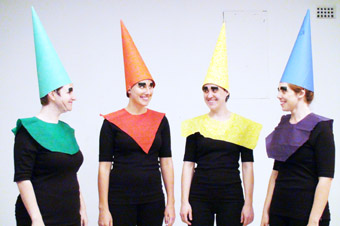performing performance anxiety
josephine skinner: brown council, big show
To enter a gallery and be greeted with something other than silence is a nice change. In the case of Brown Council’s Big Show exhibition at Locksmith Project Space, you leave with laughter ringing in your ears. Dressed as dunces, in brightly coloured cone-shaped paper hats and matching bibs, the four performer-artists laugh hysterically on a monitor, seemingly at nothing in particular, at each other’s fake laughter and at their own slapstick comedy acts in Big Show (2009), the second video piece which is projected onto the conjoining wall.
Canned laughter normally comprises brief bursts following punch-lines in sit-coms, but in the case of The One Hour Laugh (2009) it's a non-stop 60-minute endurance performance that, at least for Brown Council, sucks the fun right out of laughing. It's also a fitting accompaniment to Big Show in which there are no punch lines and the performances are laughable, in the worst sense. The acts include two dunces continuously slapping each other’s faces, a gag-inducing banana eating marathon (the bananas are pulled from inside the dunce’s pants) and a wrist- and ankle-untying escape act of undramatic writhing around on the floor.
Last time I saw Brown Council was a rather different experience—they flashed their boobs at me. I was in the audience of NightTime, an evening of short works at Performance Space where, in keeping with the Petty Theft theme, they had 'stolen' the stereotyped feminist act of bra-burning and Beyoncé Knowles’ apparently female empowering yet oddly traditionalist pop anthem “Single Ladies (Put a Ring on It)” (2008) and merged the two in a stoic performance re-asserting the need for radical feminist protest in contemporary times. I found their pop-protest moving (boob flashing may have been done before, but it is still gutsy), however there was an inescapable cringe factor that I put down to the earnestness of the act. It was missing Brown Council’s signature humour.

The One Hour Laugh, 2009, Brown Council
Humour pervades Brown Council’s live performance and performance video practice, allowing them to effectively rip apart conventions of screen, theatre and art history and critique contemporary culture, while avoiding the limitations of didacticism and the defensive reaction of audiences to overt agenda. Like Shakespeare’s Twelfth Night jester, Fester, it seems one has to be “wise enough to play the fool”, since it takes skill and sophistication to combine acute cultural insight and comedy, essentially to say something complex through something stupid. In Big Show Brown Council do just that.
The cartoon-like violence and crude acts of entertainment in the Big Show video belie a sophisticated interrogation into conventions of humour in performance, and expose the hilarity of performance, or more accurately, the absurdity of what performers endure in the name of art. The endurance factor behind Big Show’s apparently light-hearted comedy dawns as your own gag reflex sets in from watching a dunce genuinely retch (after an hour of banana ingestion), as you feel sympathy pains from seriously stinging cheeks and note the frustration, and close behind it boredom, of witnessing the escape artist's continual, flailing failing. The artists' self-inflicted discomfort recalls the performance art tradition that has embraced self-mutilation, debasement and mental anguish with performances that, were they not canonised in art history, might seem to be acts of plain stupidity. Brown Council’s humour suggests that the performance artist is the fool, the butt of their own cruel jokes. While a fair observation, this isn’t Big Show's punch line. As if accentuating the point, The One Hour Laugh aptly provides those over-the-top guffaws you hear when someone clearly doesn’t get the joke.
Rather, by embodying the ‘dunce’, a figure incapable of learning, and enacting soft-core self-harm and generally failing to perform, Brown Council doesn't satirise the performance artist so much as themselves in relation to the performance artist ‘greats.' The inane repetition of slapping and guzzling in Big Show mirrors the postmodern device which Brown Council employ, reiterating and referencing historical artworks and actions, indicating that the collective are worrying at its own capability to learn (and not just loot) from its predecessors.
Brown Council describe the notion “of the Australian artist as a shadower to European and American art histories” as the focus of their earlier 2009 work What Do I Do? (1970-2009). Here they re-enact two Vito Acconci performance pieces, in one repeatedly asking, “What do I do? What do I say?”, and in the other standing blindfolded and being hit with tomatoes. Performing their own “performance anxiety”, as they put it, continues in Big Show with the artists relegated to a corner stool (where I found one of them gallery-minding the show) and donning the dunce’s cap—like the once common form of humiliating punishment for schoolchildren not performing properly.
It is pretty funny that one of the most exciting, emerging performance and video art outfits suffers such performance anxiety and failure complex that it's had to resort to public self-flagellation. Of course, had Brown Council nothing to really contribute to art history the joke of Big Show would just fall flat.
Brown Council, Big Show, Locksmith Project Space, Alexandria, Dec 3-19
RealTime issue #94 Dec-Jan 2009 pg.






